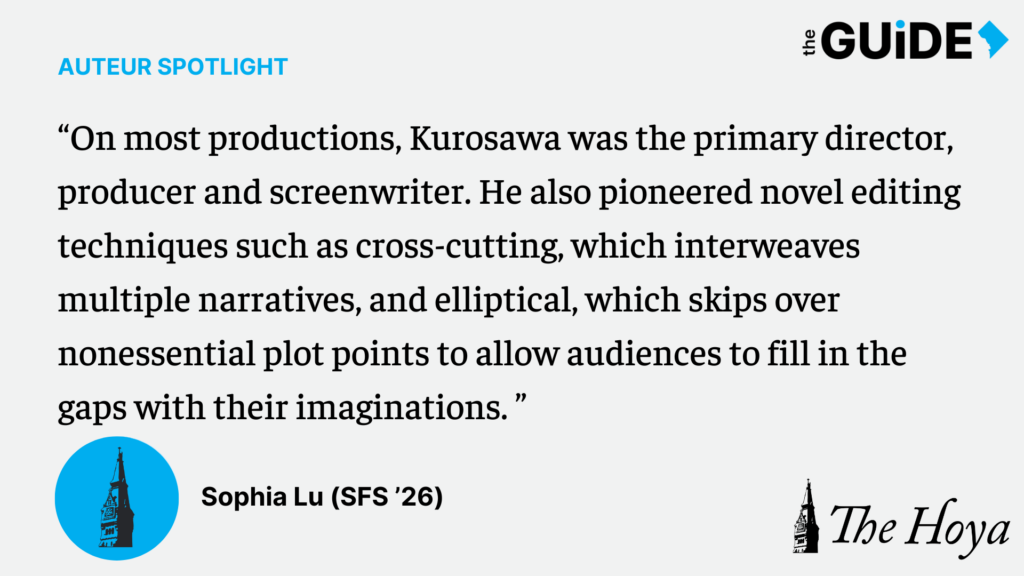The 92nd Academy Awards awarded “Parasite” the best picture Oscar, the first ever for a foreign-language film. Since then, international cinema has experienced a marked increase in prominence in the United States. “Parasite” was far from the first foreign-language masterpiece, however. Directors like Akira Kurosawa have long engaged in audacious, innovative filmmaking of their own that deserves to be recognized.
Across five decades, Kurosawa produced a remarkable filmography that drew heavily on his Japanese heritage and offered biting but thought-provoking social commentary. Coming of age in Japan in the early 20th century, Kurosawa straddled the line between his cultural past — he came from a samurai family — and his experiences in a modernized Japan during the period after the Meiji Restoration. Many themes present in his movies, such as class disparities, the human condition, and conflicts between individualism and societal duties, reflect this background.
Kurosawa is esteemed not only for his unique thematic focuses but also for his mastery of all steps of the filmmaking process. On most productions, Kurosawa was the primary director, producer and screenwriter. He also pioneered novel editing techniques such as cross-cutting, which interweaves multiple narratives, and elliptical, which skips over nonessential plot points to allow audiences to fill in the gaps with their imaginations.
Some of Kurosawa’s earliest works, like “Sanshiro Sugata,” his 1943 directorial debut, showed a penchant for perceptive experimentation. The year before, the novelist Tsuneo Tomita had published an eponymous judo-inspired novel that Kurosawa secured the film rights to before several other major Japanese studios. Kurosawa not only nailed the selection of source material, but also made “Sanshiro Sugata” into an immensely influential film by cultivating directorial trademarks. For example, he used weather patterns as a reflection of characters’ moods and abruptly changed camera speeds to alter the plot’s pace.
The second phase of Kurosawa’s directing career emerged after World War II, when he sought to highlight the realities of ordinary people in Japan. The 1948 production “Drunken Angel” shows the relationship between an alcoholic doctor and his small-time yakuza patient, whom he is treating for tuberculosis. “Ikiru,” made in 1952, follows the struggles of a terminally ill bureaucrat who searches for meaning in his final days of life.
While directing films about the contemporary, Kurosawa also made a number of powerful jidaigeki, or pieces set during the Edo period of Japanese history from 1603 to 1868. The 1950 drama “Rashomon” takes a single narrative about the murder of a samurai and tells the story through four different accounts — the bandit, the wife, the samurai himself (speaking through a medium) and an eyewitness woodcutter. As different versions unravel, audiences see Kurosawa’s philosophical investigation of the changing nature of truth and the subjective meanings of justice.
Today, “Rashomon” is widely acknowledged as one of the greatest films of all time. Filmmakers have even branded the storytelling method of providing contradictory interpretations of the same event the “Rashomon effect.” During Kurosawa’s time, the film became the first Japanese film to receive significant international acclaim. “Rashomon” won the Venice Film Festival’s top prize, the Golden Lion, in 1951 and received an honorary award at the 24th Academy Awards in 1952.
The widespread attention that “Rashomon” received pushed Kurosawa into the international limelight, allowing a larger audience to enjoy his impressive filmography. “Seven Samurai” in 1954 spotlights a village of desperate farmers who hire ronin, or masterless samurai, to fend off bandits stealing their food. “Throne of Blood,” the 1957 adaptation of Shakespeare’s “Macbeth” in a Japanese setting, demonstrated Kurosawa’s agility in putting his own spin on timeless stories.
Later on, Kurosawa produced two color epics — “Kagemusha” in 1980 and “Ran” in 1985. These films highlighted Kurosawa’s versatile integration of new technologies into his long-time filmmaking style and techniques.
With his hands-on directing, innovative editing techniques and a unique ability to humanize all kinds of stories, Kurosawa put international cinema on the map during a time when Hollywood largely dominated the worldwide filmmaking scene. His example is certainly worth spotlighting as more international films make it into the public consciousness.














